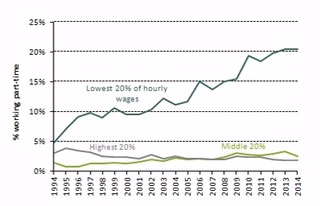A report out this morning from the Institute of Fiscal Studies has found that Twenty years ago only 1 in 20 men aged 25 to 55 with low hourly wages worked part-time. Today 1 in 5 of this group work part-time: a four-fold increase.
The report found that weekly earnings inequality among men has risen significantly. This is partly because the hourly wages of high-earners grew faster than those of middle-earners, and partly because men with low hourly wages are now working fewer hours per week.
The rise of part-time work among men on low hourly wages far predates the recession and is widespread. The trend has been occurring consistently for 20 years and is observed for low-wage men across the age spectrum, for single men and men in couples, and for those with and without children.
In contrast, inequality in women’s weekly pay fell. This is because the proportion of women working part-time has fallen, especially among those with low hourly wages (the opposite of the trend for men).
Combining the pay of men and women who live together, inequality in total earnings across working households has risen. At the 10th percentile, household earnings rose by 20% between 1994–95 and 2014–15, while at the 90th percentile, household earnings rose by 32%.
This is primarily because of the rise in male earnings inequality, since male earnings remain the largest income source for working households on average.
Despite rising earnings inequality among working households, inequality in total net household incomes (including benefits and after taxes) across the vast majority of the population is actually lower than 20 years ago.
Key reasons for this include tax credits boosting the incomes of low earners, a catch-up of pensioners with the rest of the population, and falling rates of household worklessness.
However, the top 1% have been different: their share of net total household income increased from 6% in 1994-95 to 8% in 2014-15.
Jonathan Cribb, an author of the report and a Senior Research Economist at IFS, said,
“The number of low-wage men working part time has increased sharply over the last twenty years. To understand the drivers of inequality in the UK it is vital to understand the growing association between low hourly wages and low hours of work among men.”
Chris Belfield, another author of the report and a Research Economist at IFS, said,
“In the last twenty years, the incomes of the top 1% have pulled further away from the rest. But across the vast majority of the population income inequality has actually fallen. However, in large part this is because the tax and benefit system has worked increasingly hard to offset disparities in the pay brought home by working households, and because of the catch-up of pensioners with those of working age, as well as falls in worklessness.”







